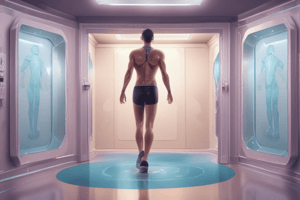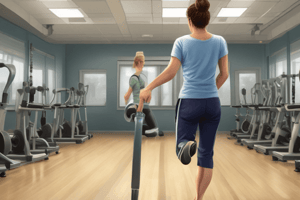Podcast
Questions and Answers
What is the most appropriate intervention for Edna, considering her osteoarthritis and the time since her arthroscopy?
What is the most appropriate intervention for Edna, considering her osteoarthritis and the time since her arthroscopy?
- Strengthening exercises focusing on quadriceps and hamstrings
- Passive range of motion exercises to maintain joint mobility (correct)
- High-impact aerobic exercises to improve conditioning
- Strict bed rest to prevent further joint damage
What position should Bart be in to maximize the efficacy of his rehabilitation for his ankle stiffness?
What position should Bart be in to maximize the efficacy of his rehabilitation for his ankle stiffness?
- Sitting with his leg dangling down
- In a prone position to alleviate pressure on the ankle
- Supine with his ankle on a pillow (correct)
- Standing while holding onto a stationary object
Which type of range of motion would be recommended for Bart to help alleviate his stiffness post-cast removal?
Which type of range of motion would be recommended for Bart to help alleviate his stiffness post-cast removal?
- Passive range of motion to prevent muscle atrophy
- Self-assisted range of motion to develop independence
- Active-assisted range of motion to facilitate movement (correct)
- Active range of motion without assistance to increase strength
What is the main goal of implementing a knee rehabilitation protocol for a patient like Edna?
What is the main goal of implementing a knee rehabilitation protocol for a patient like Edna?
What is the most crucial plane of motion for Bart to achieve a normal walking pattern?
What is the most crucial plane of motion for Bart to achieve a normal walking pattern?
In Homer’s situation, which range of motion technique would be most appropriate due to his condition?
In Homer’s situation, which range of motion technique would be most appropriate due to his condition?
What intervention technique should be avoided in the early postoperative care of a patient undergoing knee arthroscopy?
What intervention technique should be avoided in the early postoperative care of a patient undergoing knee arthroscopy?
How important is patient education regarding functional outcomes in Kaiser’s rehabilitation process?
How important is patient education regarding functional outcomes in Kaiser’s rehabilitation process?
What is the recommended dosage for Active Assisted Range of Motion (AAROM) exercises?
What is the recommended dosage for Active Assisted Range of Motion (AAROM) exercises?
In which scenario is Constant Passive Motion (CPM) most warranted?
In which scenario is Constant Passive Motion (CPM) most warranted?
What are the key considerations during Active Range of Motion (AROM) exercises?
What are the key considerations during Active Range of Motion (AROM) exercises?
What should be done for a patient with less than 3/5 strength during AROM activities?
What should be done for a patient with less than 3/5 strength during AROM activities?
What is the primary objective of passive range of motion (PROM) during the inflammatory phase of recovery?
What is the primary objective of passive range of motion (PROM) during the inflammatory phase of recovery?
What is a key benefit of the manual techniques for knee rehabilitation?
What is a key benefit of the manual techniques for knee rehabilitation?
Which therapeutic exercise is most suitable for a patient transitioning from passive to active range of motion (AROM) after knee surgery?
Which therapeutic exercise is most suitable for a patient transitioning from passive to active range of motion (AROM) after knee surgery?
What should be prioritized when selecting a positioning technique for a patient undergoing rehabilitation for knee injury?
What should be prioritized when selecting a positioning technique for a patient undergoing rehabilitation for knee injury?
Which of the following best describes what D1 Flexion entails?
Which of the following best describes what D1 Flexion entails?
When should you modify a patient's position to control for the effects of gravity during range of motion exercises?
When should you modify a patient's position to control for the effects of gravity during range of motion exercises?
What is an expected outcome of using mechanical therapy for knee rehabilitation compared to manual therapy?
What is an expected outcome of using mechanical therapy for knee rehabilitation compared to manual therapy?
When is it appropriate to progress to active assisted range of motion (AAROM) in a rehabilitation plan?
When is it appropriate to progress to active assisted range of motion (AAROM) in a rehabilitation plan?
In pain management during postoperative care, what vital signs should be closely monitored for potential pain indicators?
In pain management during postoperative care, what vital signs should be closely monitored for potential pain indicators?
How does pain management in postoperative care influence the rehabilitation process for knee injuries?
How does pain management in postoperative care influence the rehabilitation process for knee injuries?
What is a critical consideration when progressing strength training for a patient after prolonged immobilization of the knee?
What is a critical consideration when progressing strength training for a patient after prolonged immobilization of the knee?
Which technique is most appropriate for minimizing the effects of immobility in a patient with limited active range of motion following knee surgery?
Which technique is most appropriate for minimizing the effects of immobility in a patient with limited active range of motion following knee surgery?
Flashcards are hidden until you start studying
Study Notes
Case Study #1 - Marge
- Marge is experiencing pain after reaching behind to give her kids a toy
- The pain is sudden onset
- Initial stage of tissue healing - inflammatory stage
- Management goals should focus on protecting and resting the injured tissue, reducing pain and inflammation
- Interventions should include modalities such as ice, elevation and gentle passive range of motion exercises
Case Study #1 - Marge - One Month After Injury
- Marge's pain is ongoing, indicating that she is still in the inflammation stage
- The plan of care needs to be adjusted to focus on moving into the subacute stage of healing
- Interventions should aim to reduce inflammation, control pain, and promote healing
- Modalities may include: light heat, gentle active range of motion, and pain management techniques
Case Study #1 - Marge - Limited Motions
- Shoulder abduction and external rotation are likely to be the most limited motions based on her symptoms
Case Study #1 - Marge - Positioning
- Positioning for intervention should be comfortable and supportive
- Examples include: supine, side-lying, or sitting with proper support
Case Study #2 - Edna
- Edna is 65 years old with osteoarthritis in her knees
- She has undergone arthroscopy to clear out debris in the knee joint
- Two weeks post-surgery - Edna is in the subacute stage of healing
Case Study #2 - Edna - Limited Motions
- Stair climbing is a complex activity requiring hip flexion, knee extension, and ankle dorsiflexion
- The most limited motions in this scenario are likely knee flexion and ankle dorsiflexion, as they are essential for negotiating stairs
Case Study #2 - Edna - Positioning
- Positioning for Edna should prioritize comfort and support for her knee
- Examples include: supine, side-lying, or sitting with proper support
Case Study #2 - Edna - Range of Motion
- Active-assisted range of motion (AAROM) is an appropriate choice considering Edna's age and osteoarthritis
- AAROM allows for gentle movement while reducing the strain on the joint and muscles
- Passive range of motion (PROM) can also be incorporated, but active movement is crucial for promoting healing and regaining function
Case Study #3 - Bart
- Bart is a 16 year old who sustained an ankle fracture requiring a cast for 6 weeks
- He has difficulty walking after the cast was removed, reporting stiffness as his main complaint
Case Study #3 - Bart - Ankle Motions for Walking
- Ankle dorsiflexion and plantarflexion are crucial for a normal walking pattern
- Inversion and eversion also play a role in heel to toe progression
Case Study #3 - Bart - Plane of Motion
- The sagittal plane is most important for Bart's goal of walking
- It allows for the necessary ankle dorsiflexion and plantarflexion for propulsion and foot clearance
Case Study #3 - Bart - Range of Motion
- Active range of motion (AROM) is the most beneficial exercise for Bart at this time
- It promotes active engagement of muscles and helps regain full ankle mobility
- Light resistance exercises can also be incorporated progressively as tolerance and strength increase
Case Study #4 - Homer
- Homer is a 36-year-old male who sustained a traumatic brain injury in a motor vehicle accident and is currently in an induced coma in the ICU.
Case Study #4 - Homer - Range of Motion Exercises
- Passive range of motion (PROM) can be performed
- Rationale: Since Homer cannot actively participate due to his condition, PROM helps prevent joint stiffness and maintain muscle length.
Case Study #4 - Homer - Education
- The patient's family, staff and loved ones can be educated on the benefits of promoting ROM
- Key points: Explain the purpose of PROM and how it contributes to overall recovery.
- Communication with healthcare professionals is paramount to ensure the safety and appropriateness of any intervention, particularly in a high-risk situation like Homer's.
Studying That Suits You
Use AI to generate personalized quizzes and flashcards to suit your learning preferences.




